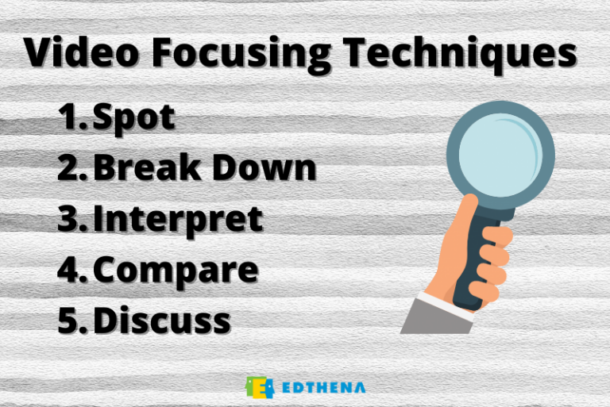Feeling Stuck with Video Analysis? Try These 5 Effective Video Focusing Techniques
When doing video analysis of your teaching, it can be tempting to comment on everything you see and tag every moment.
But is this truly effective for learning and growth? Trying to analyze everything at once could lead to feeling overwhelmed and not knowing what to focus on for improvement.
It’s helpful to have a more targeted approach for your video analysis.
The Focusing Techniques for Analyzing Video from Evidence of Practice: Playbook for Video-Powered Professional Learning are research-informed ways of analyzing classroom video for self-reflection and instructional improvement.
From noticing details in your videos to discussing them with others, we’ve explained each video focusing technique below.

Spot: The first step in building video analysis skills
While watching your teaching videos, you can notice more details than you’d be able to during the lesson. Classrooms move at a fast pace and there’s a lot that can be missed in the moment.
The Spot focusing technique helps you notice meaningful moments, interactions, or patterns of behavior. These moments might differ from what you expected or illustrate important principles of teaching and learning.
For example, you may notice where you placed your classroom homework return folder.
Perhaps the folder placement is affecting classroom efficiency. Now, you can reflect further on effective routines for your classroom.
Spot helps you build video analysis skills because you practice identifying specific moments as important to zoom in for your professional growth.
Break Down: Examine your teaching practices
Teaching is a complex, multi-step process. Break Down is about separating the components of your instructional practice into individual steps.
Break Down is helpful for understanding how you’re doing at adopting specific pedagogical moves by analyzing complex instructional sequences as components that build upon each other.
For example, if your goal is improved behavior management, you can break that down into the smaller skills of giving clearer instructions and giving students positive reinforcement.
You can intentionally practice the smaller pieces of an instructional goal for better mastery of your craft.
Interpret: The key to accelerated teacher learning
Beyond just noticing, the Interpret technique helps you unearth root causes behind behaviors and events that you’re noticing within student actions or teacher actions.
Perhaps you’ve noticed that you pose challenging questions to one group of students more often than another group and decide to examine this pattern. When you’re analyzing using the Interpret focusing technique, you’re starting to ask “Why is this happening?” and “What are the underlying things that are leading to this situation?”
Interpreting your actions and behaviors, or your students’, means reflecting on the context of the situation and what happened before the moment that contributed to a particular outcome. That can then help you make sense of and address what is happening in your classroom.
Compare: Looking at multiple pieces of evidence
Compare is the focusing technique related to analyzing two or more pieces of evidence.
This might mean comparing two moments from the same lesson or two examples of the same pedagogical move across two lessons.
The Compare technique helps you uncover much more than you’d initially think.

Take the apples above. The immediate difference between the two batches is color. But a further comparison might reveal that they taste different, sweet versus tart. Despite a similar shape, they may have different textures or firmness.
Push yourself to go beyond the immediately noticeable similarities or differences in your classroom video analysis. If a classroom procedure was successful in one instance and not in another, look closer at what may have actually been different between them.
Looking more closely to compare will sharpen your insights and help you identify more specific next steps for improvement.
Discuss: Collaborate with others
The video focusing technique of Discuss involves analyzing teaching with others, in order to elicit, understand, and consider various perspectives and ideas.
The other four focusing techniques are possible to do alone. The choice to use discussion is a shift from “reflecting on my teaching” to “talking together about teaching.” It takes your video self-reflection and expands it to include multiple perspectives.
This is a chance for your colleagues to pose questions, suggest alternative interpretations, and help you examine the thinking behind decisions. And sometimes, colleagues can help uncover information from a video that is otherwise going unnoticed.
Bringing your video analysis to a group setting will bring more eyes and ears to all of the focusing techniques.
Committing to self-examination and growth
Whenever you decide to do classroom video analysis, it reveals a willingness to be vulnerable and an openness to continual growth in your teaching.
Reflecting on your teaching with video shows a commitment to an honest examination of your teaching practices in the interest of better student outcomes.
When you pair this openness and growth mindset with the Focusing Techniques for Analyzing Video, you’ll get the most out of your self-directed learning and growth.
Want to learn more about this topic? Check out our past post, Use these Powerful Video Focusing Techniques to Accelerate Teacher Learning, Encourage Deep Reflection, and Facilitate Rich Discussions, and also read the book Evidence of Practice: Playbook for Video Powered Professional Learning
